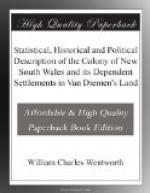FOREWORD
There can be little doubt that when my great-grandfather began to write this book, his thoughts were centred on the objective which he describes in his own Preface—the diversion to Australia of some part of the stream of emigration then running from the British Isles to North America. Perhaps, even more urgently, he may have wanted to forestall any British tendency to withdraw from the colony and abandon New South Wales altogether.
But as he wrote, he found that he had to make some explanation for the defects which he saw in the current life of the colony, and naturally he was led into propounding some way in which these defects could be overcome. Contemporary reviewers, then, were not so far wrong when theycommented that the book looked almost like two books written by separate hands.
The secondary theme became the most important part of the book, because the remedies he then proposed for his country’s ills became the guidelines for his own policies when he returned to Australia. Through the influences which he and his friends exerted over the next thirty years, these policies determined much of the course of Australian history in those times. Most of his proposals were eventually accepted, though in some cases much later than he wanted, and in some cases with modifications which he himself made or which were forced on him by the pressure of events.
At the time he wrote this book he was in his middle twenties, having returned to England to complete his education soon after participating in the first crossing of the Blue Mountains. Waterloo had just been won; Europe was settling down and trying to forget Napoleon. The wounds of the American Revolution were closing; British merchants and industrialists were preparing to change the face of the world in accordance with the precepts of Adam Smith.
In his attempt to divert the migration stream he was no enemy of America, (indeed he had chosen the name “Vermont” for his own farm on the Nepean) but he was perhaps the first Australian really to support Macquarie’s drive for Australian expansion and Australian independence from London administration. He did this at a time when some influential Englishmen were urging the abandonment of the whole Botany Bay venture, which, after thirty years, was still not self-supporting and which seemed doomed to suffer from recurrent crises.
Apparently Macquarie had dreamed of a great transcontinental river, which was to flow 2,000 miles westwards from the Dividing Range, through fertile and well-watered fields, until it reached the sea somewhere on the north-west coast. The Lachlan had been found to peter out into swamps, but Oxley believed that the Macquarie River would have a happier issue, and at the time of the first Edition of this book (1819) that theory was still tenable. It was not long, of course, before these hopes were to perish in the Macquarie Marshes, to be succeeded by prospects of a mythical Inland Sea, though it was decades before the enthusiasts realised that they would have to be satisfied with Lake Eyre.




